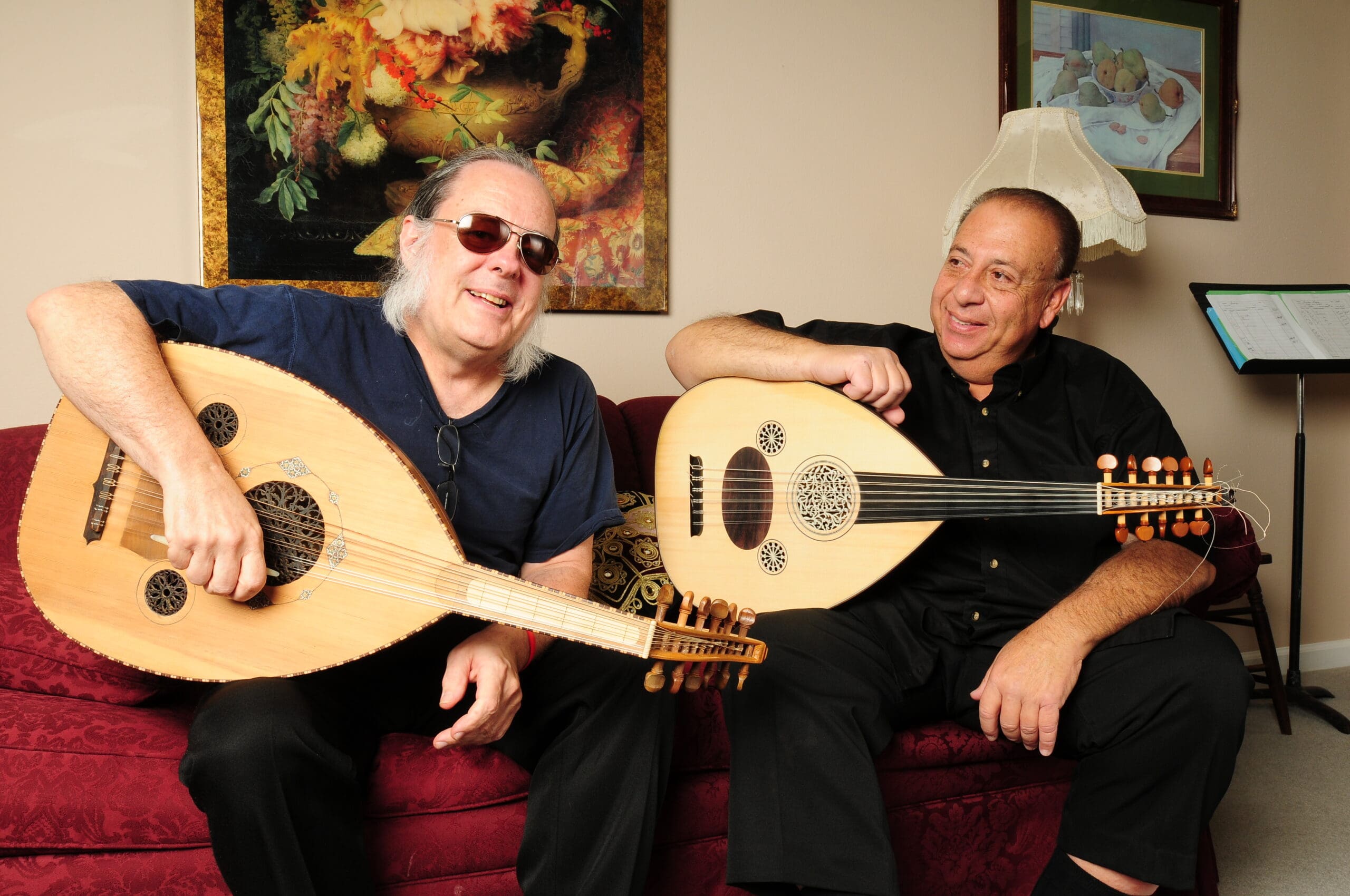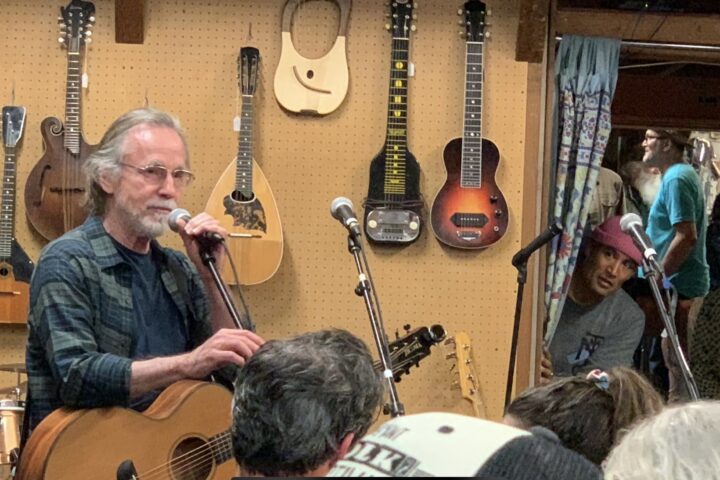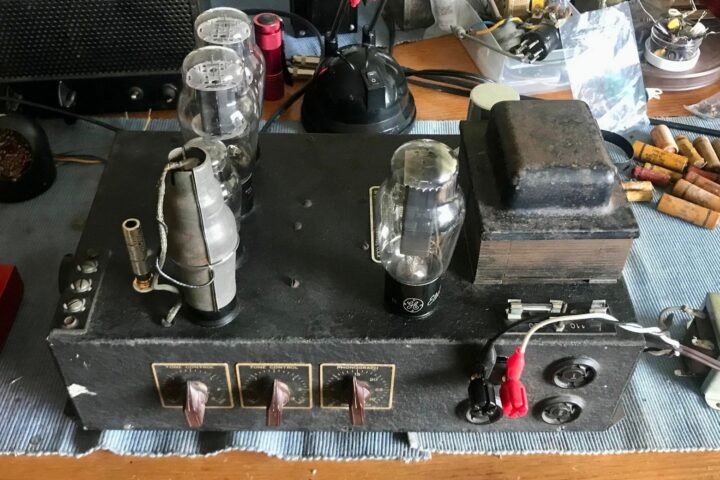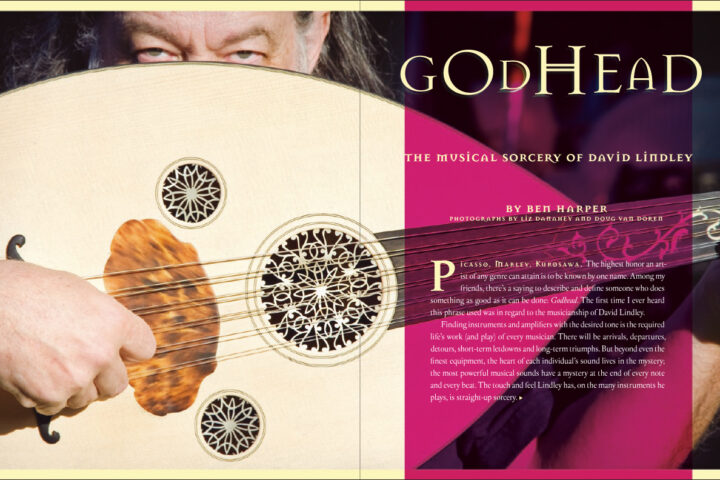Are we sure that he was even human?
I hung out with David Lindley half a dozen times, I heard all the music, I drove him around Seattle in my car, I saw his house in Claremont, California, and I endlessly talked to the musicians who knew (and worshipped him). I still don’t fully know the answer to that question.
It’s inexplicable how one human could be a virtuoso of so many things. How did he do it? How could he make the lap steel – not exactly the most tonally diverse instrument, generally speaking – stand out so much that you can recognize a Lindley solo from the ‘70s within a few seconds? That 1966 Kaleidoscope album? El Rayo-X? His uncanny Jimmy Stewart impersonation? “Tiki Torches at Twilight?” The singular fashion sensibility? Was there anything he couldn’t do? It’s otherworldly.
This much we know: He was born in San Marino, California. There was a great record collection, a piano, and a ukulele in the house. Lindley took up the violin, then played baritone ukulele, and then, sometime around high school, a five-string banjo. In one of his best interviews, he told Steve Dawson on the Music Makers and Soul Shakers Podcast the whole chronology, how he got the Pete Seeger book, how his uncle, the Ricardo Montalbán (!!!), ended up gifting him his first guitar.
The woodshedding details we may never know (in the comic book version of our hero’s life, this would be a convenient place for the radioactive asteroid to land, giving him fretted instrument superpowers). Next thing we hear, he’s winning the annual Topanga Canyon Banjo Contest so many times (five) that they just threw their hands in the air and made him a judge. It’s all staggering: Lindley was still a teenager and already had his 10,000 hours under his belt on more than one instrument. How did that happen?
“I won under Three-Finger Bluegrass Picking and then Traditional – separate divisions. And then they finally told me, “Lindley, don’t enter anymore!” So they made me a judge. And I said, “You mean I’m supposed to judge people’s musical worth?” And they said, “Yeah, you can do that.” –Lindley to Ben Harper, Fretboard Journal 11
If we accept that he was from this planet, we can also agree that he was a byproduct of the unique melting pot that was Southern California in the ‘60s. There were venues like the Ash Grove, the Troubadour and the Cat’s Pajama’s, music stores like Claremont’s Folk Music Center and Pasadena’s Barry and Grasmick’s to frequent, there were luthiers working on all sorts of instruments in East LA (not to mention the bigger CA-based makers like Fender and Standel), and musicians Clarence and Roland White alongside all the touring blues and folk acts and talented young peers…Lindley soaked it all in.
There was also Disneyland.
The one time I interviewed Steve Martin for our 30th issue, I broke the ice by talking about Lindley. Both worked at Disneyland. Though he was only a year older than Martin, Lindley was already a virtuoso, playing banjo and fiddle for the Mad Mountain Ramblers in the theme park’s Frontierland. “I worked at Fantasyland and the girl who worked there liked to go visit a boyfriend,” Martin told me. “So we made a deal where I could go take a 15-minute break and watch the Mad Mountain Ramblers and then she could go visit her boyfriend. It was fantastic. David Lindley was staggering on the five-string banjo.
“He used to stand on his toes when he played,” he added. “I copied that for several years. There’s this old record, I just found it the other day, as a matter of fact, where he plays ‘Clinch Mountain Backstep.’ And he’s still got a little avant-garde thing going on, even then.”
Avant-garde. That’s a pretty great summation of Mr. Dave in general. From those early banjo moments (at least two of his pure bluegrass banjo tracks seem to have found their way to compilations on Spotify), to Kaleidoscope, to those legendary Jackson Browne and Warren Zevon sides, El Rayo-X, and his solo (and duo) albums, Lindley was always experimenting, always…avant-garde. Or, to be more exact, always Lindley. The Lindley sound wasn’t a bakelite Rickenbaker through a Dumble Overdrive Special, it was all these things – lap steels, fiddle, the oud, banjos, Hawaiian guitar, the laugh, a profound love for reggae – every time he played.
One of my favorite Lindley tunes wasn’t a Lindley tune at all; it was written by Greg Copeland. Every time I heard Lindley play “Revenge Will Come” live – and, of course, Lindley never played it the same way twice, or even on the same kind of instrument – I was moved. Lindley’s opening notes would become a prelude to all the themes housed in the song; his voice would tell the story just right, never overdoing it. I was always left wondering why no one else covered this seemingly great song.
But I think it was all Lindley. He outdid the original Copeland version. Voicing it the way only he could, he’d play it on a comically large hollowbody lap steel and could make a grown man (me) cry. He could transform a lot of songs. “Bye Bye Love” re-invented with a reggae beat? Sure; it’s on the blue El Rayo-X album. “Minnie the Moocher” as played by a jug band? Of course.
As in music, when it came to gear Lindley gravitated towards the exotic. He was throwing Gibson pickups into Fenders decades before modding became a thing; he dusted off old harp guitars for rock stages a decade before Robbie Robertson did; his experiments with using the pre-amp of a reel-to-reel in front of his Fender amp led to him discovering a up-and-coming amp tech Howard Dumble. He’d often tour with his Paddy Burgin-built Weissenborns and an oud. He had a solidbody oud. Who else but Lindley would even own such a thing?
For the last couple of decades, it was rare to catch him ever playing a regular, six-string (“Spanish”) guitar at all. During one of his visits to our headquarters, I sheepishly asked him to play my Henderson 000-28. He got 95% of the way through Zevon’s “Indifference of Heaven” before quitting in spectacular Lindley fashion. It couldn’t get any better.
Beyond the music, Lindley’s sense of style was alien. The polyester clothing, the muttonchops, that smile…he was that rare guitar hero who wasn’t afraid to clown around. He was a guest on one of our first podcast experiments and, for a while, I thought he was going to do the whole interview as Jimmy Stewart. Now I sort of wish he did.
The music business changed a lot over the decades, but Lindley didn’t. He kept making beautiful and exotic music; he kept seeking new sounds. His website was ancient and he never bothered with social media. Into his mid-70s, right before COVID, he’d cram his car with self-released albums and tour, putting on the fancy shoes one more time. He was a perennial favorite at venues and festivals from Vancouver Island to Southern California, and around the world. He stayed impossibly funny, brilliant, and singularly David Lindley. And I’m glad that – whoever he truly was – we shared this planet for a little while.

Lindley interviewing his oud hero, John Bilezikjian, for the Fretboard Journal #19. Photo: Gary Newkirk


